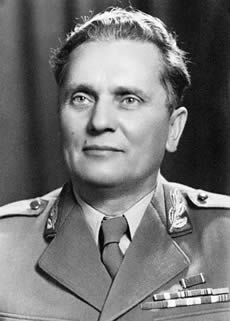During this period, he defied Joseph Stalin over the communist consolidation of power in Yugoslavia. "Tito" was a pseudonym that he adopted during his underground activities, and it was with this name that he became well known during World War II.
Tito was born in the village of Kumroves, some 50 kilometers northwest of Zagreb in what was then Austria-Hungary. His native village is located in the valley of the river Sutla, which served as a boundary between Croatia and Slovenia. Tito’s father was a Croatian peasant, and his mother was Slovenian from a village across the river.
In 1907, at the age of 15, he left home and went to the town of Sisak (Croatia), where he became an apprentice to a locksmith. Tito completed his apprenticeship in 1910 and began a series of mechanic jobs, which took him to factories across central Europe.
  |
In the autumn of 1913 Tito was called up for his military service, which he did with the 25th Croatian Territorial Infantry Regiment based in Zagreb. When Austria-Hungary attacked Serbia in July 1914, Tito, already a sergeant, was sent to fight on the Serbian front.
In January 1915 his regiment was transferred to Galicia in anticipation of a Russian offensive. There Tito was put in charge of a reconnoitering section operating behind enemy lines. However, during a Russian attack in April 1915, he was seriously wounded and taken as a prisoner of war (POW).
It was during this time that Tito began sympathizing with the ideas of Bolshevism. In June 1917 he escaped from the POW camp and made his way to Petrograd in search of work, but the suppression of Bolshevik demonstrations forced him to flee to Finland.
While attempting to cross the border he was captured and sent back to the POW camp, but he escaped on the way and arrived in Bolshevik-controlled Omsk in Siberia in autumn 1917. He enrolled in the Red Guard and applied for membership in the Communist Party.
 |
| Marshal Tito and Winston Churchill in 1944 in Naples, Italy |
When the Bolsheviks retook Omsk in 1919, he started making his way back to Croatia. Tito returned to Kumrovec in October 1920, where he found that his village had become part of the new Kingdom of Serbs, Croats, and Slovenes (changed to Yugoslavia in 1929).
Upon his return he joined the newly founded Communist Party in Zagreb and became active in the union movement. During the 1920s he worked as a mechanic in factories across Yugoslavia. In 1927 he became secretary of the Metalworkers’ Union of Croatia.
His activities brought him to the attention of the police, and in August 1928 he was arrested. Upon his release from prison in 1934 Tito resumed full-time clandestine activities for the Yugoslav Communist Party.
In February 1935 he was sent to Moscow for training with the Balkan Department of the Comintern. He stayed there until September 1936, when he was sent back to consolidate the Yugoslav party and recruit volunteers to fight in the Spanish civil war.
During 1937 the factionalism within the Yugoslav Communist Party increased, and in the atmosphere of uncertainty Tito asserted his authority by setting up an interim secretariat under his leadership. Moscow offered him provisional approval in the beginning of 1939, and Tito was officially confirmed as a secretary at a party congress in October 1940.
In April of 1941 the Axis powers invaded, occupied, and partitioned Yugoslavia, which triggered a civil war in the country. Tito formed the Partisan Army of National Liberation, which waged guerrilla war against the occupying forces. In the process Tito’s partisans also turned against rival guerrilla organizations, in particular the internationally recognized "Chetniks" of Draža Mihailovic´.
Tito and his partisans emerged victorious from the war, and, despite his promises to form a government of national unity, he immediately began consolidating his authority and establishing communist rule over the territory of Yugoslavia.
At the same time Tito was entertaining ideas of leading a Balkan federation involving Albania, Bulgaria, and potentially Greece. The prospect of a regional federation under Tito’s leadership seemed likely during 1947 and brought Tito into a direct confrontation with Stalin.
In 1948 the Yugoslav Communist Party was excluded from the Cominform (the postwar name for the Comintern), and this turned Tito into the first communist leader to break with the Soviet Union. This gave him both new international prominence and domestic appeal, which helped him consolidate his position in Yugoslavia.
In domestic affairs Tito promoted the principles of brotherhood and workers’ self-management (a form of market-oriented socialism), in parallel with his ongoing suppression of internal dissent.
His death in 1980 was a shock for the country, and the seeming stability of Yugoslavia began to crack under the strains of national factionalism. Many commentators trace the origins of the 1990s Yugoslav dissolution to Tito’s authoritarian rule.
